Suomenniemi Museums
The Municipality of Suomenniemi is near the town of Mikkeli and is part of the South Savo region within South Karelia. Suomenniemi museums are two in number, the Lyytikkälä Museum Farm (open over the Summer months) and the Nikkinen Cottage (note that the Nikkinen Cottage is only open on Suomenniemi-festival days).
Lyytikkälä Museum Farm
Address: Pajulahdentie 17, 52830 Suomenniemi Map>>>
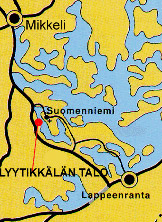
Inquiries: Phone: 044 0880 676
Opening Days & Times: 12th June-12th August (i.e. Summer months only): Tuesday-Sunday 12 midday to 6pm, Mondays closed
Museum Website: http://www.etelakarjalanmuseot.fi/lyytikkala-museum-farm/
Getting there: The Lyytikkälä Museum Farm is in in the village of Lyytikkälä at Suomenniemi near the Mikkeli-Lappeenranta highway (Highway 13).
The Museum is perhaps South Karelia’s best preserved farming estates and gives you a real insight into 18th and 19th century farming life. In 2002 this Museum was voted South Karelia’s ‘Local Museum of the Year’ – it’s well worth a visit.
Lyytikkälä Museum Farm history
The Lyytikkälä Farm’s history begins in 1722 when one Matti Tuomaanpoika acquired the land which had been abandoned during the period of the Great Wrath (1713-1721) – the farm then remained with the same family for over 250 years. During the late 19th century Vilppu (Filip) Lyytikäinen’s management led to Lyytikkälä becoming one of the major estates of the area, increasing in size to 400 hectares. At the same time, additional buildings on the farm were constructed and formed an enclosed courtyard around the main building. The last owner of the farm was Esko Nieminen (1909-1979), the son of Vilppu Lyytikäinen’s daughter. In 1984 his heirs sold the farm buildings and their furnishings to the National Board of Antiquities. Following completion of restoration work on the farm buildings over the years 1986-1989, the Lyytikkälä Farm Museum opened to the public in 1989.
Access to Lyytikkälä Museum Farm
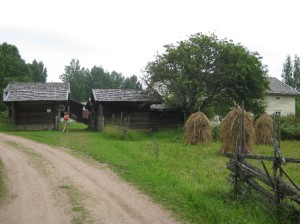
Access to the farmyard area is down the lane along which can be found grain barns and the drying-barn. A barn and threshing shed used to be located on the lane, but were removed at one stage. The layout of the buildings along the lane was largely due to practical considerations (in winter, transport and loading always took place via the lane, which was kept open for this purpose).The lane leads into the yard. In the past, the road to Lyytikkälä passed by the farm’s sheds and barns and through the yard area itself. This can be seen in the buildings themselves, in which only the walls facing the yard, or road, were painted. The road that passes behind the sheds and barns was laid in 1916-1917. The lane continues on the other side of the yard, the so-called “lower lane” which is bordered by birches and leads to the shore of the nearby lake. The water route was previously more important than the roads. Savitaipale led to contact with the ships to Lappeenranta.
The Lyytikkälä Farmyard
The courtyard of Lyytikkälä Farm is surrounded by some twenty outbuildings which include sheds, storage buildings, stables, barns, a cowshed as well as the farmhouse itself. The yard area includes the “front garden”, which is actually behind the farmhouse and contains an orchard of apple trees as well as berries. The “back garden” is a fenced vegetable garden at the end of the cowshed. In the early twentieth century, apples were a major source of income for farms in the parish of Suomenniemi.
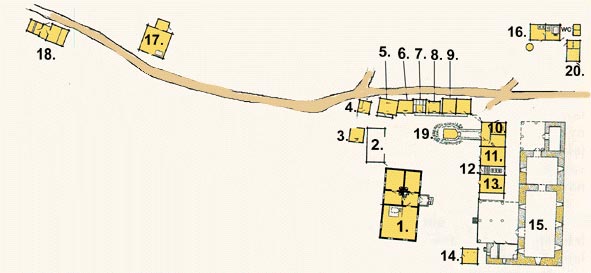
| 1. Farmhouse 2. Woodshed 3. Garden shed 4. Salt store 5. Stable |
6. Middle store 7. Flour store 8. Maids´ shed 9. High barn 10. Stable |
11-13. Sheds 14. Dowry bldg 15. Cowshed 16. Sauna 17. Drying barn |
18. Grain barns 19. Cellar 20. Mtce bldg |
The granaries and storehouses of Lyytikkälä Farm were built at various times from the 18th to the late 19th century. The older of the two stables was built in 1827 by Elias Lyytikäinen, the father of Vilppu Lyytikäinen. The newer stable was built in 1843 and was used up until the late 1970’s.
The Lyytikkälä Farmhouse
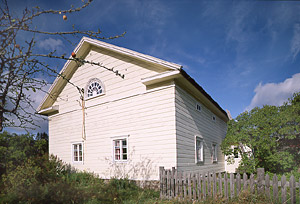
The Lyytikkalan-farmhouse exterior
Vilppu Lyytikäinen, the then owner of the farm, constructed the farmhouse in 1867. The biggest room, the tupa (used for living and cooking) takes up half the house’s floor space. This room has a large baking oven which is typical to Southern Finland, the dampers for which can be opened and shut with rods hanging down from the ceiling. In front of the oven is a double-walled range. Opposite the tupa on the other side of the entrance space there is a kitchen which also served as a pantry. This room was used more as a storeroom than for cooking and has a square hatch in the floor where dirt could be swept into.
Fixed benches are built along the walls of the main room (the tupa) while along the back wall there are beds. In years past, the sons of the owner, the farm-workers and visiting guests slept here at night (in summer, they slept in the farm sheds). “Mikko’s bed”, named after Mikko Halinen (ca. 1850-1930), a long-term farm-hand at Lyytikkälä, can be seen in the corner between the oven and the wall. Mikko Halinen’s name is also associated with other places on the farm.
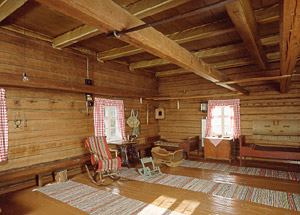
The Interior of the Lytikkalan-farmhouse.
The master and the mistress of the farm slept in the “front bedroom” at the end of the entrance space while the daughters of the house slept in the “back bedroom” (which later became the parlour when it was no longer used as a bedroom – at which time it became the “best” room in the house. The interiors of the front bedroom and the parlour have survived more or less unchanged from the early twentieth century.
The main building windows are made up of six panes of glass. In the living rooms, the top panes are separated by a wide dividing frame, with colored glass used in the openings. This glass is probably from the same consignment as was used in the Suomenniemi Church windows. Parts of the previous farmhouse (dating from the early 19th century) survive on the farm as the old house was put to alternative use when the current farmhouse was built. The bedroom of the older house became the woodshed and until the 1960s, the tupa from the older farmhouse saw use as a barn on the upper lane.
The Lyytikkälä Farm Sheds and Stables
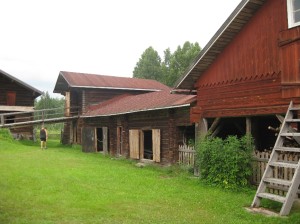
Lyytikkalan Farm Sheds
There are a number of farm sheds, among them the garden shed (used as the master’s spirits store) and probably built in the 1860s, possibly by the same master builder who built the farmhouse. One of the older buildings at Lyytikkälä is the Salt Shed, built in the 1790’s. The flour store was built in the 1770’s, making it one the oldest buildings, and has a barrel-vaulted ceiling. This shed as large flour bins along the walls and contains other objects associated with foodstuffs.The maids’ shed (also with a barrel-vaulted ceiling) was built in the 1770’s and was used by farm workers to live in during the summer months. More recently constructed buildings include the high barn, a two-storey, four-room loft barn probably built in the 1840’s, coinciding with the older stable (built in 1843). The rooms in the loft barn were used to live in during summer (with the exception of the windowless “old store room”, where bodies were placed while they waited on being buried). The dowry house at Lyytikkälä was part of the dowry of Anna Kääriö of Lehmälahti, the second wife of Vilppu Lyytikäinen (he went through three wives). They were married in the early 1890’s, after Vilppu was widowed in 1892.The dowry included the present grain store, two cows, rye and a rocking chair. The dowry house was used as a store for clothing and other articles.
Lyytikkälä Farm includes two stables, the older of which is a two-storey building built when Elias Lyytikäinen, father of Vilppu Lyytikäinen, was owner and master. An engraving in a log in the left wall gives 1827 as the year of construction. Sixteen years later, in 1843, the new and larger stable was built, a two-storey structure, with the actual stable on the ground floor and a loft on the upper floor with access via a wide ramp. The floor of the loft contains a hatch used to drop hay down into the stable. The stable was in use until the 1970s.
The Lyytikkälä Farm Cowshed
The cowshed is one of the more interesting buildings on the Lyytikkälä Farm, with walls almost two metres thick built from large stone blocks. Different parts of the cowshed were built at different times with the oldest walls being built between 1877 and 1881. This also included a kitchen space for heating water, with its own well. At the beginning of the twentieth century a smaller sheep stable was added on to the cowshed. Cows were kept in the large shed; calves were kept in a corner enclosure; and the small addition was used for sheep. A pigpen was built in 1930, this is the youngest addition to the cowshed. The main entrance to the cowshed has a large overhanging roof supported by pillars – the loft above was used as a feed store.
Miscellaneous Factoids
The Lyytikkälä Museum Farm and the adjoining cafeteria are open daily 12.00 – 18.00 during the summer (1 June – 15 Aug). There is an admission charge for the café to adults of €2, children are free.
During the 1960s, three ethnographic films were shot on Lyytikkälä Farm: ‘Summer in Suomenniemi – Summer jobs on the farm’ (1962); ‘Autumn in Suomenniemi – Autumn jobs on the farm’ (1962); and ‘Winter in Suomenniemi – Winter jobs on the farm’ (1963). The films, which focus on the traditional agricultural working methods, can be seen in the cafeteria.
Lyytikkälä Museum Farm together with its courtyard, buildings and their contents was purchased by the Finnish National Board of Antiquities and Historical Monuments in 1984 and opened to the public in 1989. The museum is jointly managed by the Board and Lyytikkälä Museum Farm Foundation.
Nikkinen Cottage
Address: 52830 Suomenniemi, kirkonkylä Map >>>
Inquiries: tel. 050 340 8627
Opening times: during traditional local Suomenniemi-festival days only and by prior arrangement
The Nikkinen Cottage is close to the Suomenniemi municipal library. The Regional History Society of Suomenniemi has preserved and displaued various items and memorabilia of historical value in this cottage (originally owned by Constable Nikkinen and opened to the public in 1981). Associated with the cottage are two granaries
The cottage is built of local timber and has three rooms. These contain a range of exhibitions. The main room of the cottage contains a magnificent old baking oven. The room is furnished with the original furniture, including benches, a table, a wooden couch and a bed. An old loom is also on display. In one corner of the room can be found a large tub with a cowlstaff (the cowlstaff was used to carry the tub on the shoulders).
In the bedroom visitors can admire the impressive display cabinet which is home to medals and cups belonging to the well-known local athlete, Adam Solkia. The bedroom also hosts many temporary exhibitions, such as the one organised in summer 2002 which displayed a collection of handicrafts made by the craftspeople of Suomenniemi. On show in the dining room is an assortment of crockery and old-fashioned dishes, along with a milk separator and women’s clothing from the 19th century.
Interesting Sites Nearby
Astuvansalmi Rock Paintings, Ristiina (15,5 km)
Kärnäkoski Fortress, Savitaipale (18,1 km)
Savilahti Stone Sacristy, Mikkeli (42 km)
Mikkeli Cathedral, Mikkeli (41,4 km)
Taavetti Fortress, Luumäki (45,3 km)
Places to Stay Nearby (within 20kms)
Note that Mikkeli is around 40kms distant, an easy drive and has plenty of places to stay. There’s quite a bit of accommodation available in Southern Karelia (see here for more information) as well as plenty to see and do. Best suggestion is to pick somewhere you think you’ll like as a base based on your personal accommodation preferences and do day trips. Anyhow, for those who would like to stay somewhere nearby, here are a few suggestions.
Globalfreeloaders.com has one member near Suomenniemi – you will need to signup to check this out as things change (more on Globalfreeloader & members in Finland here)
Kauppisen Lomamökit: Haukiniementie 545, 52850 Halmeniemi (These are lakeside cottages 12.9 km from Suomenniemi) – http://www.kauppisenlomamokit.com/en/index.php
Lomakeskus Tommolansalmi: Kouvolantie 2216, Tommola (These are lakeside cottages 16.6 km from Suomenniemi)
Kartanohotelli Olkkolan Hovi: Olkkolantie 2, Savitaipale (This is a Hotel in an old mansion 17.4 km from Suomenniemi) – http://www.olkkolanhovi.com/
Rantatalo B&B: Kaijanlahdentie 10, Savitaipale (around 18 kms from Suomenniemi) – this is a small (4 guest apartments) B&B that doesn’t have it’s own website but is more affordable than many of the alternatives. You can find them on www.booking.com or on www,tripadvisor.com
Or of course you could choose to stay at an established hotel in one of the larger towns nearby such as Mikkeli (click here for accommodation in Mikkeli) or Lappeenranta (click here for accommodation in Lappeenranta).
 Copyright secured by Digiprove © 2013 Alternative Finland
Copyright secured by Digiprove © 2013 Alternative Finland



One Response to Suomenniemi Museums